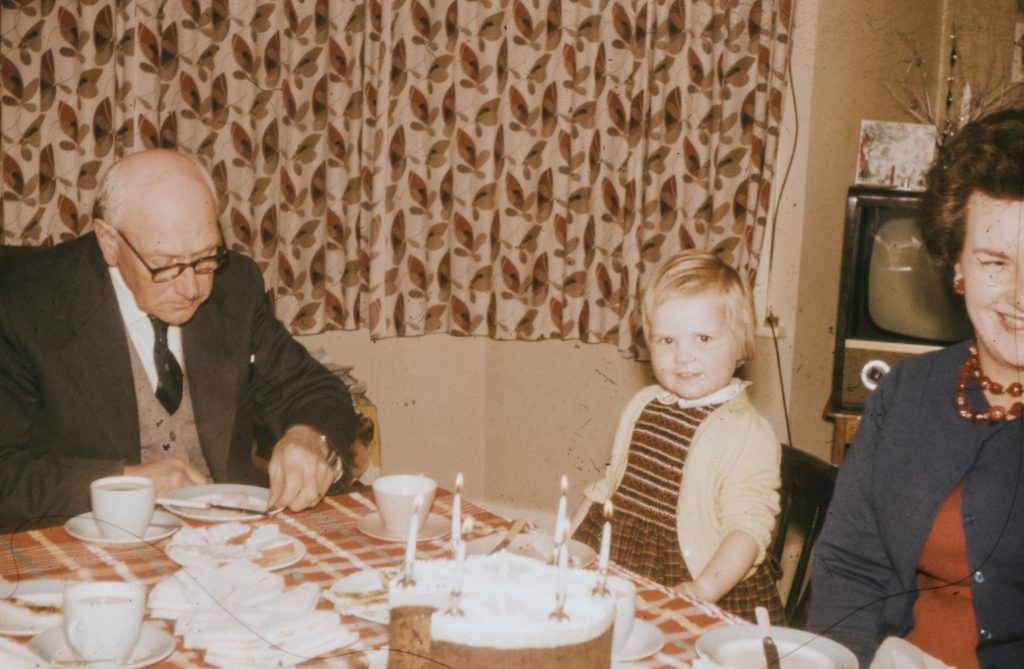
Because the most common symptoms of Alzheimer’s disease include disorientation, mood swings, loss of motivation, failure to manage self-care, and behavioral issues, a great deal of recent research into possible palliative care treatments has focused on the clinical potential of reminiscence therapy. This unique therapeutic approach engages all the senses in order to help curb all of the most insidious symptoms of Alzheimer’s and other forms of dementia.
Reminiscence therapy is an intervention technique used to counsel, treat, and support patients with Alzheimer’s and other forms of cognitive and neurodegenerative disease. It has been found to help Alzheimer’s patients cope with the agitation and anxiety that often come from extreme forms of disorientation, memory loss, and confusion. This therapeutic intervention uses oral performance, writing exercises, informal and structured conversation, touch-based activities, and even environmental immersion, in order to help participants calmly project themselves back into a time from which they can recollect their strongest memories — usually between the ages of 10 and 30.
The American Psychological Association (APA) defines reminiscence therapy as “the use of life histories – written, oral, or both – to improve psychological well-being. The therapy is often used with older people.” It is an effective treatment for people in their later years who have mood and memory problems, or who may simply have difficulty dealing with the prospect of aging and the passage of time.
Typically, by using prompts such as photographs, music, poems, clothing, and other physical objects, a therapist (or even a beloved family member or trusted caregiver) and a patient discuss memories from earlier in life over the course of a reminiscence therapy session. However, in recent years, other forms of stimuli–such as environmental immersion and drama therapy–have been found to be effective forms of reminiscence. Many recent studies point toward reminiscence therapy as an effective tool for improving a general sense of well-being, maintaining and regaining a certain degree of cognitive functioning, and reducing social withdrawal among people with Alzheimer’s disease.
The Background & History of Reminiscence Therapy

Up until the late 1950s, reminiscence among the elderly was widely considered to be a negative symptom of aging. Patients were discouraged from reminiscing as they grew older, as it was believed that it could often lead to mental deterioration or remaining “stuck in the past.”
Around this time, psychologist and professor Erik Erickson proposed his theory of the eight stages of psychological development through which a person typically progresses during their lifetime. Erickson postulated that the eighth and final stage occurred during late adulthood, at roughly 60 years of age and older. According to his work, the primary virtue of late adulthood is wisdom, and people in this life stage experience a psychosocial crisis of ego integrity versus despair. This leads us to ask ourselves the crucial question while looking back at our life: “Is it okay to have been me?”
Erickson suggested that, as we seek to answer this question and reflect meaningfully on our lives, we develop a sense of integrity and wholeness if we see ourselves as having led a successful, fulfilling life. However, if we see our life as having been unproductive, we often become dissatisfied and may develop a sense of despair. It becomes important for a person to look back upon one’s life with a sense of satisfaction, drawing meaning even from challenging times and obstacles. With the introduction of Erickson’s work into the psychological canon, the idea that retrospection could be a negative symptom of aging leading to mental deterioration began to be challenged.
The next important advancement in the development of reminiscence therapy came in 1963, when psychiatrist Dr. Robert Butler published a paper describing the clinical importance of reminiscence and the positive psychological effects of reviewing one’s life in late adulthood. He is often regarded as the founder of the reminiscence therapy movement. Butler proposed that the process of reminiscence could contribute to the onset of certain common late-life disorders, particularly depression. However, if reminiscence was engaged in a positive and effective process, it could also lead to the development of positive characteristics such as candor, serenity, and wisdom among people in late-life stages.
After Dr. Butler’s work championed reminiscence as a potentially key clinical tool, the work of psychologist Dr. Charles Lewis in 1971 led to the first experimental study of reminiscence therapy. Lewis studied how reminiscence could affect cognitive changes and, in turn, people’s perceptions of themselves. Lewis’ work led to several years of research focusing on the functions and benefits of reminiscence. In 1978, the U.S. Department of Health and Social Security started a project called “The Reminiscence Aids Project,” which was geared at using reminiscence as a therapeutic tool, thus cementing reminiscence therapy as a widely recognized, evidence-based method.
From this time forward, institutions began to recognize and utilize reminiscence therapy for individuals and as a form of group therapy. The number of psychological professionals trained in reminiscence as a therapeutic process began to increase, with many clinicians acknowledging nostalgia as a powerful emotion that could be effectively plumbed for positive medical purposes. As the field has evolved, there is now an ever-growing number of therapeutic interventions being developed.
One case study exemplifies the power of reminiscence therapy when it’s fully fleshed-out and thoroughly realized. In the Netherlands, the town of Hogeway, just outside of Amsterdam, is an outdoor 1950s-style village with around 150 inhabitants. The nostalgia-powered destination boasts a town square, theater, central garden, and post office, all recreating key aspects of the elderly residents’ childhoods and evoking familiar sights, sounds, and experiences. The most unique thing about Hogeway (or Dementia Village, as it was dubbed by CNN) is that all of the residents have some form of dementia, Alzheimer’s, or other form of neurodegenerative disease. The caregivers dress in street clothing, and the elderly residents are encouraged to participate fully and explore the community. According to reports, the elderly inhabitants live longer, require fewer medications, and report higher levels of well-being than do typical seniors.
Trauma therapy is also an encouraging recent therapeutic intervention within the broader realm of reminiscence therapy. Two professors from the University of Haifa, Israel, published a paper in 2017, concluding that reminiscence therapy which integrated drama therapy could lead to increased self-acceptance, healthier interpersonal relationships, and a sense of successful aging and meaning in life. It also decreased depressive symptoms in some senior patients.
How Reminiscence Therapy Works

Numerous papers have been published in recent years attesting to the clinical efficacy of reminiscence therapy. Studies have found that it can decrease depression as an alternative to antipsychotic medications, which can have high costs and harmful side effects; that group-based reminiscence therapy using Internet videos can improve cognitive functions and decrease levels of apathy among older people with Alzheimer’s; that it has the potential to assist in maintaining cognition and decreasing symptoms of depression in institutionalized elderly persons; and that five weeks of immersive reminiscence therapy can improve autobiographical memory recollection if completed in a setting filled with concrete clues suggesting the time period of the participants’ youth. Experts recommend that regular integration of reminiscence therapy should be included in the routine care of people with Alzheimer’s, particularly in institutional, assisted living, and group-based settings.
The overarching goal of reminiscence therapy is to aid a person in feeling integrated as a “whole person” and connected to the current moment. This can seem counterintuitive, because reminiscence therapy so actively engages the past, but elderly patients can use the approach as a way to remind themselves of positive memories and to nourish their overall sense of personal identity. The sessions can be conducted either formally or informally among individuals, groups, and even families. While the stimuli are rooted in the past, the end goal is to encourage the Alzheimer’s patient to communicate and interact with the listener in the present.
Reminiscence therapy is rooted in engaging with patients at all moments throughout the day in order to encourage positive interactions during routine times such as meals, bedtime, and bathtime, as well as while taking medications and dressing, and even during light physical exercise. Because of this, it lends itself to integration in many daily activities. In individual settings, it can help a caregiver interact more positively with a patient while assisting them with activities of daily living. In group settings, it can build camaraderie and understanding among senior patients, who can learn to relate to one another more readily.
This form of therapy is largely about acknowledgment, supportive listening, and the positive associations that come from actively remembering. Instead of continuous reminders of what they have forgotten, patients are allowed to focus on and be validated for the things they can remember. The modern world can feel invalidating and incapacitating to elderly people in general, and especially those with Alzheimer’s disease. Cell phones, Blu-ray players, remote controls, and other modern technologies can be difficult to figure out and can lead to a decreased sense of self-worth and a feeling of incompetence. Focusing on youth and available memories allows elderly people to focus on the wisdom they’ve acquired through the years and to reaffirm the importance of their hard-earned knowledge and time-honored maturity.
Open-ended questions can be very important for engaging older patients. How long have you and your husband been married? Who was your best friend growing up? Did you go to college? Such questions transport the patient to a specific time in the past during which they may have specific associated memories. They allow the patient to reminisce about a particular time and place. It is also important to remember to engage in active listening, provide positive responses, ask appropriate follow-up questions, and account empathetically for the emotions that are brought up. While not necessary, it might be helpful to share your own experiences as an offer of solidarity.
Questions aren’t the only way to trigger memories as a form of therapy. Different stimuli have different psychological effects. Reminiscence therapy requires refined observational skills in order to provide clues about what is important to the patient. Many household objects, such as mementos, souvenirs, photographs, blankets, jewelry, clothing, and even furniture can be especially helpful prompts while reminiscing.
Moreover, prompts can work upon any of the five senses; music, movement, dance, photographs, smells, and food will all trigger memories in different ways and are all opportunities to guide the discussion in new directions. Many patients with Alzheimer’s disease are experiencing impairment to their short-term memories, while retaining relatively intact long-term memories. Using different stimuli will evoke different memories and different periods of a patient’s life. This may lead to forms reminiscence that seem relatively everyday, but which are nonetheless important to validate the life story and experiences of the patient. One recent study suggests that because Alzheimer’s disease patients may have fragmented memories and only remember parts of the story at a time, it may be a good idea to record, transcribe, and edit the story fragments in order to reconstruct a coherent whole.
Diet and cooking, favorite songs, early life experiences, the shape and layout of a childhood bedroom, birthday presents from specific years of childhood, births and deaths of relatives, celebrations, weddings, and personal collections all form important parts of our identities as individuals, so it is important to actively listen and respond. Facilitators can engage these memories not only through conversation, but also through cooking, crafts, and other everyday activities.
One nice thing about reminiscence therapy is that there are very few negative side effects. Nonetheless, common consideration and certain precautions should always be taken. Many memories are not pleasant, and reminisces may give individuals an opportunity to express their bitterness over disappointments from their life. It is entirely possible that a patient may remember a sad or difficult time in their life over the course of recollection, although this is not necessarily a negative. Even recounting painful memories affords a chance for a patient to be transported back into a life-changing story and to re-engage with their long-term memory. Negative memories can also be engaged in a more empowering way, with less of the sting of immediate grief and pain. Patients can learn to re-frame their painful histories in more empowering or healing ways.
The Results of Reminiscence Therapy

Reminiscence therapy is now widely regarded as possessing the positive potential of becoming a nonpharmacological intervention for aging patients with Alzheimer’s disease and other forms of neurodegenerative disease. It validates patients’ sense of self-worth and allows the patient to look back and re-experience their life events, re-framing them in an empowering way with the added benefit of retrospective wisdom. Reminiscence therapy also has been found to encourage people with cognitive dysfunction to extract, analyze, and repeat significant information from their past, which in many cases allows them to strengthen personal memories and retain those memories for longer periods.
These effects often help to alleviate depression, which is a common and debilitating symptom among people with Alzheimer’s. Thus, reminiscence therapy has been found to have a positive effect on emotional functions as well as cognition.
A few recent studies have suggested that an added positive effect of reminiscence therapy includes increased, strengthened coping skills. These researchers suggest that this unique therapeutic approach increases patients’ abilities to manage and deal with new or challenging situations in an effective, healthy manner.
All of these effects can lead in turn to an improvement in patients’ overall quality of life — particularly in terms of overall happiness and mood. It seems exceptionally important to engage patients in reminiscence therapy rather than unstructured free time, as facilities that do so report a significantly higher sense of well-being in their senior residents. Improved mood is strongly related to social interaction among elderly patients in particular, and research suggests that patients with Alzheimer’s disease withdraw less from group settings and interact more with others after participating in reminiscence therapy.
The results of reminiscence therapy are positive, not just for the senior patients themselves, but also for caregivers. Cognition and behavior alike do seem to improve among the Alzheimer’s patients who participate in reminiscence, which can in turn help to reduce day-to-day stress on caregivers. Caregivers have reported a reduction in their overall stress levels while performing their jobs, increased ability to differentiate meaningfully between patients, and improved knowledge of individual needs.
Overall, reminiscence therapy has been found to be a potentially beneficial approach to ameliorating the symptoms of emotional distress that are commonly associated with Alzheimer’s disease and other forms of dementia, as well as a means of boosting cognitive function and retaining long-term memory. It is an inexpensive, noninvasive, and nonpharmacological way to provide a general feeling of life satisfaction, validate the experiences of elderly patients, and lend patients a crucial sense of security, self-awareness, and serenity.





